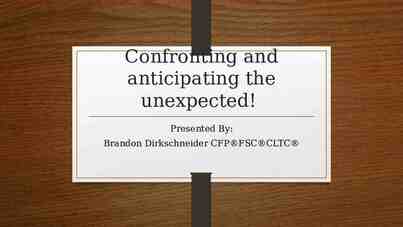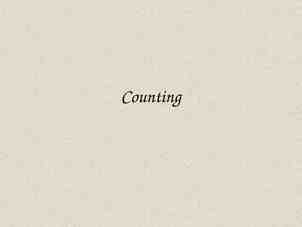Basic Concepts of Financial Accounting Introduction to Business
68 Slides534.50 KB
Basic Concepts of Financial Accounting Introduction to Business And Technology
The Basic Accounting Equation Financial accounting is based upon the accounting equation. Assets Liabilities Owners' Equity – This is a mathematical equation which must balance. – If assets total 300 and liabilities total 200, then owners' equity must be 100.
The Basic Accounting Equation The balance sheet is an expanded expression of the accounting equation.
The Basic Accounting Equation Balance Sheet Assets Liabilities and Owners’ Equity Cash 5,000 Accounts receivable 7,000 Inventory 10,000 Equipment 7,000 Total assets 29,000 Liabilities Accounts payable Notes payable Total liabilities Owners’ equity Total liabilities and owners’ equity 8,000 2,000 10,000 19,000 29,000
Assets Assets are valuable resources that are owned by a firm. – They represent probable future economic benefits and arise as the result of past transactions or events.
Liabilities Liabilities are present obligations of the firm. – They are probable future sacrifices of economic benefits which arise as the result of past transactions or events.
Owners' Equity Owners' equity represents the owners' residual interest in the assets of the business. – Residual interest is another name for owners' equity.
Owners' Equity Owners may make a direct investment in the business or operate at a profit and leave the profit in the business.
Owners' Equity Yet another name for owners' equity is net assets. – Indicates that owners' equity results when liabilities are subtracted from assets. Owners’ Equity Assets – Liabilities
The Basic Accounting Equation Both liabilities and owners' equity represent claims on the assets of a business.
The Basic Accounting Equation Liabilities are claims by people external to the business.
The Basic Accounting Equation Owners' equity is a claim by the owners.
A transaction may do one of several things: It may increase both the asset side and the liabilities and owners' equity side. It may decrease both the asset side and the liabilities and owners' equity side.
A transaction may do one of several things: It may cause both an increase and a decrease on the asset side. It may cause both an increase and a decrease on the liabilities and owners' equity side.
A transaction may do one of several things: Regardless of what transaction occurs, the accounting equation must be in balance after the transaction is analyzed.
Transaction Analysis
Transaction Analysis
Transaction Analysis
Transaction Analysis
Transaction Analysis
Transaction Analysis
Transaction Analysis
Transaction Analysis
Revenues and Expenses Revenues increase owners' equity. Expenses decrease owners' equity.
Revenues Revenues are inflows of assets (or reductions in liabilities) in exchange for providing goods and services to customers. – A retail store such as Wal-Mart earns revenues by selling goods to customers. – A CPA firm earns revenues by providing services such as tax return preparation or auditing.
Revenues Critically important point: – Cash need not be received in order for revenue to be recorded. – Revenues are earned when a company does what it is supposed to do according to a contract.
Revenues Accounts receivable are promises by a customer or client to pay cash in the future.
Revenues A related concept concerns cash received before a service is performed or goods are delivered.
Consider the following example: A magazine company receives 24, which represents a year's subscription. The subscriber, of course, pays in advance.
Consider the following example: The magazine company may not record revenue because it has not earned revenue yet.
Consider the following example: To earn revenue, it must send the subscriber one magazine a month for twelve months.
Consider the following example: It owes magazines to the subscriber and thus has a liability (called Unearned Revenue), not revenue.
Consider the following example: As magazines are sent, revenues may be recorded.
Consider the following example: Unearned revenues are usually settled by the performance of a service, unlike other liabilities which are usually settled by the payment of cash.
Revenues
Revenues
Expenses Expenses occur when resources are consumed in order to generate revenue. They are the cost of doing business. – Examples include rent, salaries and wages, insurance, electricity, utilities, and the like.
Expenses
Expenses A critically important point similar to that for revenues holds true for expenses. – A business need not pay out cash in order to have to record that an expense has occurred.
Expenses A critically important point similar to that for revenues holds true for expenses. – If a repairman comes to the business to work on the air conditioning system, then the business has a repair expense even though that work may be charged to its account.
Expenses A critically important point similar to that for revenues holds true for expenses. – The company will have a liability which it will settle later with the payment of cash.
Expenses The word "payable" is usually used in a liability title.
Examples of Payables Notes payable—written obligations. Accounts payable—unwritten obligations that arise in the normal operations of a business. Wages payable.
Examples of Payables
Sales of Inventory Sales of inventory contain both revenue and expense components.
Sales of Inventory A revenue transaction exists because an asset has been obtained and goods have been provided to customers.
Sales of Inventory An expense transaction exists because an asset has been consumed to generate the revenue.
Sales of Inventory The resulting expense is called cost of goods sold.
Sales of Inventory
Adjustments to Accounts Several adjustments must be made to accounting records at the end of the accounting period.
Adjustments to Accounts A balance in an account may need to be adjusted because of the passage of time and the occurrence of events in that time period.
Adjustments to Accounts An amount may not have been recorded in an account at all. – The amount will have to be recorded before the financial statements are prepared so that all the information will be correct.
Revenues and Expenses Remember that four transactions affect owners' equity. – Owner investments increase owners' equity. – Owner withdrawals decrease owners' equity. – Revenues increase owners' equity. – Expenses decrease owners' equity.
Simple Balance Sheets and Income Statements The end result of the accounting process is the preparation of financial statements.
The Balance Sheet The balance sheet shows a firm's assets, liabilities, and owner's equity at one point in time. – The date on the balance sheet will be a single date, such as December 31 or June 30.
The Income Statement The income statement summarizes a firm's revenues and expenses for a period of time. – The date on the income statement will be a phrase such as, "For the month ended July 31," or "For the year ended December 31."
The Income Statement If revenues exceed expenses, then the result is net income. If expenses exceed revenues, then the result is a net loss.
The Income Statement Only revenues and expenses appear on the income statement. – Students sometimes think that cash is a good thing and should appear on the income statement. – Cash is an asset and so will appear on the balance sheet.
Income Statement For the Month Ended January 31, 2000 Revenues Sales Service 4,000 650 Total revenue Expenses Cost of goods sold Rent Salary Depreciation Interest Utilities Total expenses Net income 4,650 2,200 1,000 700 208 133 120 4,361 289
The Statement of Owners' Equity The statement of owners' equity summarizes the changes that took place in owners' equity during the period under review.
The Statement of Owners' Equity It will have the same date as does the income statement. It shows results over a period of time, not just at one point in time.
The Statement of Owners' Equity The statement starts with the beginning balance of owners' equity and adds in any owner investment and net income. If there are withdrawals, then they are subtracted, as is a net loss.
The Statement of Owners' Equity A business will have either a net income or a net loss, not both.
The Statement of Owners' Equity
Relationship Between Balance Sheet and Income Statement Changes in net income, owner contributions, and owner withdrawals, all of which affect owners' equity, explain changes in net assets.
Forms of Business Organization Profit-oriented enterprises can be organized in one of three ways. – Sole proprietorships – Partnerships – Corporations
Basic Concepts of Financial Accounting End of Accounting Basics









































































